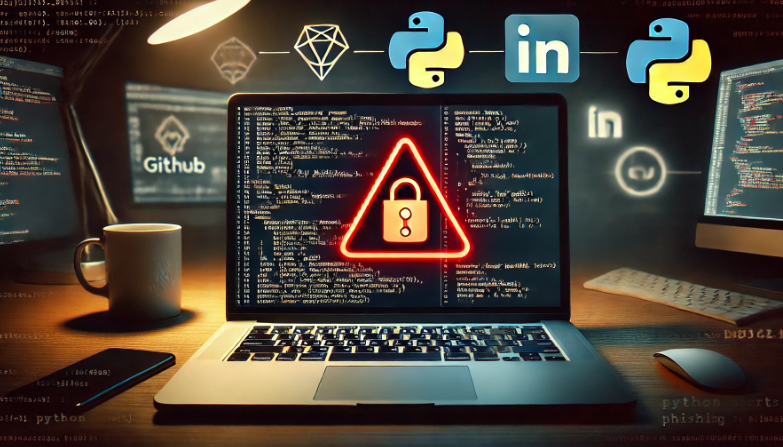In the ever-evolving world of cybersecurity, sophisticated attackers are leveraging increasingly creative tactics to compromise systems. One such emerging threat, reported recently, involves the use of fake coding tests, designed to trick developers into executing malware. This article delves into the specifics of how attackers, specifically the Lazarus Group, have targeted Python developers by posing as recruiters offering coding challenges that are, in reality, part of a malicious campaign.
The VMConnect Campaign
The cybercriminals behind these attacks are part of the notorious Lazarus Group, a North Korean hacker collective. Their latest tactic involves impersonating recruiters from reputable companies and targeting software developers—particularly those with Python expertise. Under the guise of offering job opportunities, the attackers present their targets with a coding test that appears to involve creating or debugging a password manager.
The campaign, dubbed VMConnect, first emerged in August 2023. It involves planting malicious Python packages in repositories like PyPI, a widely used platform for sharing Python code. By injecting malware into these packages, the attackers exploit developers who unknowingly download and run the malicious code on their systems.
How the Attack Unfolds
The attackers employ a multi-step approach to compromise their targets:
- Recruitment Ploy: Developers are approached via professional platforms such as LinkedIn, where they are offered lucrative positions at high-profile companies like large U.S. banks. The lure of an attractive employment package adds to the perceived legitimacy of the approach.
- Malicious Coding Test: The fake job applicants are asked to participate in a coding test designed to evaluate their ability to work with Python projects. The test files are hosted on GitHub, and victims are directed to read through professional-looking README files containing detailed instructions.
- Execution of Malware: In this coding test, developers are tasked with debugging or finding a bug in a password manager application—PasswordManager.py. However, upon running this file, it triggers the execution of a hidden, obfuscated malware downloader. This payload is concealed within the ‘init.py’ files of legitimate libraries like ‘pyperclip’ and ‘pyrebase.’ The obfuscation is achieved through base64 encoding, making it more challenging for antivirus tools to detect.
- Command and Control: Once executed, the malware establishes communication with a remote command and control (C2) server. From there, the attackers can issue commands to the infected system, potentially allowing them to download additional malicious payloads, steal data, or compromise the victim’s broader network.
Why This Attack Is Effective
The attack’s success relies on several key factors:
- Time Pressure: The README file sets a strict time limit for completing the coding test—five minutes to set up the project and an additional 15 minutes to find and fix the bug. This urgency discourages thorough code inspection, increasing the likelihood that developers will execute the malicious script without performing standard security checks.
- Professional Disguise: By mimicking real-world recruitment processes and utilizing platforms like LinkedIn and GitHub, the attackers make their campaign appear legitimate. The README files are designed to convey a sense of professionalism and trustworthiness, making it harder for victims to spot red flags.
- Exploitation of Trust: Developers, especially those eager to land a high-profile job, are more likely to trust coding assignments provided by potential employers. This trust is further amplified by the use of well-known platforms and the impersonation of reputable companies.
Mitigating the Risk
Developers and organizations can take several steps to defend against these kinds of attacks:
- Verify Recruiter Identities: Before engaging in any job recruitment process, especially if it involves receiving files or assignments, verify the identity of the recruiter. Contact the company directly through official channels to confirm that they are actively recruiting.
- Use Virtual Environments: Always test unfamiliar code in a virtual machine (VM) or sandbox environment to isolate potential malware from your primary system. This prevents malicious code from having access to sensitive information.
- Inspect Code Thoroughly: Even when under time constraints, developers should thoroughly inspect any code they receive from unverified sources. Use tools to check for obfuscated code or hidden payloads before executing any scripts.
- Educate Developers: Companies should prioritize educating their developers on cybersecurity best practices, including how to spot phishing attempts, recognize malware, and respond to suspicious recruitment offers.
Similar Cases in Cybersecurity
The Lazarus Group has a long history of leveraging social engineering attacks in combination with technical exploits. This case is reminiscent of earlier campaigns where malware was delivered via malicious job offers, particularly targeting cryptocurrency firms and government agencies. Similarly, other hacking groups have used job-related phishing tactics to compromise systems, such as those described in previous attacks like the Operation Dream Job.
Additionally, malware-laden software packages, particularly in open-source repositories, have been a recurring problem. Instances where malicious code was inserted into legitimate software distribution channels, such as npm or PyPI, emphasize the importance of vetting all dependencies and third-party libraries.
Conclusion
The rise of fake coding tests as a means to deliver malware highlights the evolving tactics of cybercriminals like the Lazarus Group. As software development becomes an increasingly targeted profession, it is crucial for developers to remain vigilant, question unexpected requests, and implement robust security measures. As these threats continue to grow, a combination of awareness, education, and technical defenses will be key to safeguarding against such attacks.
By remaining cautious and adhering to best practices, developers can better protect themselves from falling victim to these sophisticated phishing campaigns and preserve the integrity of their systems and data.

